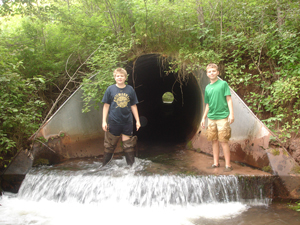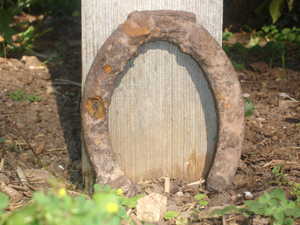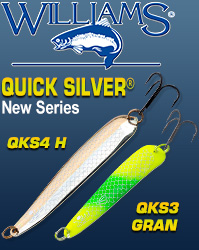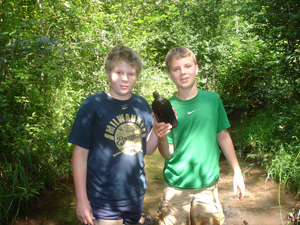Fencerows Column “The Stream of Time”
|
|
 End of the line for the Sandy Run fishing expedition. |
 Horseshoe pulled from the streambed of Sandy Run. |
By John Luthens
It was a bright morning with just a hint in the air of autumn days to come. Goldenrod was shining in the fields as the neighbors plucked tomatoes from a backyard garden. The stream of time was changing seasons, but the end-of-summer sky still seemed the limit.
It started with a simple bike ride with my son. Back to school was upon us and we needed to suck the summer stream dry before it iced over. Maybe a late season fishing pond would reveal itself, or a good patch of blackberries. Maybe we’d follow a wandering animal track till sundown, all that good outdoor stuff. The garage-sale sign wasn’t really in our wheelhouse. It was more of an impulsive whim when we turned down the side road and followed the pointing arrow.
As it turned out, we came away from the confines of the garage with a haggled box of old baseball cards (duly noting that neither of us are a collector.) We burned the rest of the day, beautiful sunshine, blackberries and wispy clouds included, sorting out 30 years worth of baseball’s boys of summer in a shadowed corner of our basement.
So much for a last hurrah – but we were helpless to stop it. You never can tell what debris might float up from the depths and log jam the stream of time. We still don’t have the foggiest idea if we got swindled on the baseball-card box or not.
You’ve got to take what the stream of time offers up, wade right in and wallow around. On a late-summer trout fishing expedition a few weeks back, we did just that, entering the stream of time in Douglas County below the small village of Brule.
It was another custom-built day, with sun coming down in shafts through the pines, and with just enough of a breeze to force the blood sucking mosquitoes into an uneasy stalemate. My son and a friend geared up with me, and we set off on our quest.
Now, the Bois Brule River swings through town on its way to Lake Superior. It is a fantastic trout fishery for big brown and rainbow. In my opinion, one of the state’s finest. It is also a first-rate scenic waterway for canoe enthusiasts.
After finding that we only had one pair of waders and one pair of hip boots between the three of us, and noting that it was one of the last Saturday’s of summer - one of the heaviest days for canoe traffic - we opted off the bigger water and the bigger trout.
I have hooked a passing canoe with a fly rod before, and while the thrill of the initial hook-up is pretty cool, the fight is extremely short-lived. Unless of course the canoeist happens to be a big burly guy, then the fight can last longer than hooking into a trophy blue marlin.
I have also filled my waders more times than I can count on the big river. Hip boots don’t stand any chance at all. And the unlucky third person who drew the short straw would end up wading chest deep for hours in a pair of shorts. The icy spring-fed water would be invigorating to the fullest sense of the word – not to mention I’d throw a tantrum if I drew the short straw.
Our expedition veered up an alder-choked tributary of the Bois Brule called Sandy Run, not big enough to float a canoe - you could practically leap across it in spots. But it was cold enough to cut right through you if you missed your footing on the leap. It bubbles from the surrounding valleys artesian style, staying in the balmy range of 65 degrees Fahrenheit year round.
Sandy Run winds below a brushy hillside on the edge of the village of Brule. It was the focus of stream improvement and conservation work by the Brule River Sportsman’s Club from 2007 through 2009. The club cleaned deadfall debris out of the stream which had created small dams, causing sand to build up and widen the channels. Once the woody debris was cleared, the sand slowly shifted out of the holes and the stream deepened, exposing clay bottom and vastly improving trout habitat and spawning access.
With the sand washing away and exposing more spawning access for trout, history was slowly revealed with it. Brule was founded as a logging and railroad town around 1884, with copper mining, farming, along with tourism, fishing and hunting exploits thrown in for well over 100 years. Waiting like a patient historian below the town, Sandy Run was a natural accumulation point.
As the earliest frontier settlement of a small town in northwestern Wisconsin slowly unfolded into modern times, Sandy Run accumulated more than its share of artifacts. The Sportsman’s Club cleaned out the majority of the big stuff, tires and buckets and piles of old bricks. Bottles, cans, and old pieces of clay pottery came out next. Due to the clubs efforts, the stream habit of Sandy Run slowly wound back its environmental clock.
Still, every year, depending on rainfall and snow-melt runoff, new artifacts rise up from Sandy Run’s stream of time. Our fishing trio learned this as we followed a winding course upstream. I’m not sure who saw the first dark glass bottle poking up from the sand and clay bottom- it was a 1945 pint whisky bottle with the Federal Government stamp still raised on the glass, but soon all thoughts of fishing went out the window and a virtual treasure hunt was on along the tree-tunneled banks.
I found an iron-crusted horseshoe half buried in the bottom. The last time a horse crossed down the Sandy Run valley is open to speculation. I’m no carbon-dating scientist, so I’ll venture an amateur guess of a really, really long time.
A sculpted jar dating from 1901 was pulled out of the clay along with several more whiskey bottles. One of the bottle’s pressed-glass label traced its origins to Minot, North Dakota, which according to historic legend was nicknamed “Little Chicago” during the Prohibition years of the 1920’s, and was a hub of Al Capone’s liquor smuggling operations.
Our rods and reels were cast and forgotten along the bank. The gear would be retrieved later when we came back for what we couldn’t carry. I kept my fishing creel strapped over my shoulder, and let me tell you that the clanking of pint whiskey bottles into a horseshoe is a lot heavier and noisier than any mess of trout I’ve ever laid into.
At the end of the journey, a culvert rolled beneath the highway on the outskirts of Brule. We never saw a fish. In fact, I don’t remember even fishing at all. We came through the culvert and up the slopes of Sandy Run, ending the fishing trip nonetheless. We walked back arm in arm through the historic town of Brule with a limit of treasures.
My son sold his 1901 jar to an antique dealer. I think the agreement was struck in the ballpark of five dollars. Like the garage-sale baseball cards, neither of us has any business sense regarding the value of such things. But hey, for a thirteen-year-old kid, five bucks is five bucks.
The whiskey bottles look neat stacked on a shelf, even though they’ve long ago given up their real intrinsic and potent value.
And the horseshoe – that, I’m keeping close to my side. Tomorrow’s another day in the stream of time. Lord knows I need all the luck I can get.
Author’s note- After I titled this story, I happened across the website of Len Harris, an author, photographer and first-rate trout fisherman from Richland Center. Len’s website is devoted to all things trout, including beautiful pictures and fine writing. He has published a book, coincidently named “The Stream of Time,” which has been in existence a lot longer than any scribbling I’ve done on the subject of searching out old whiskey bottles.
Not wanting to infringe on another fisherman’s secret hole (not that I’m above doing so when it comes to big trout), and not wanting to get sued for copyright infringement (which I’m pretty sure I am above, but lack the money to find out), I contacted Len, who graciously insisted that I keep the name of my story. In fact, he even invited me trout fishing.
Len’s website is http:// www.lenharris.blogspot.com - His book is available on Amazon.com under the title “The Stream of Time”. If you want to see fantastic musings and photos of trout-fishing in Wisconsin’s Driftless Area - in a land where the glaciers never penetrated, the views are long, and the streams of time run wild with trout - then Len Harris is definitely worth checking out.










